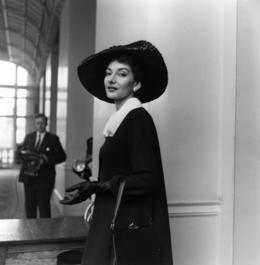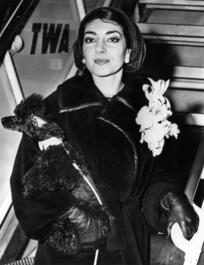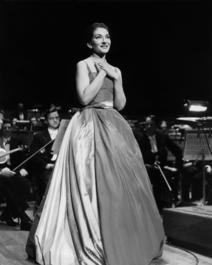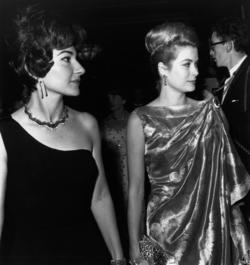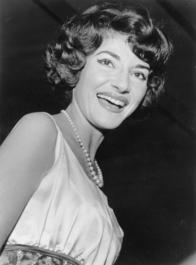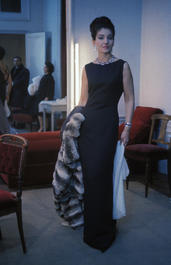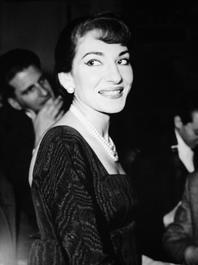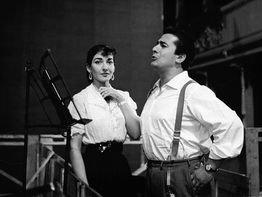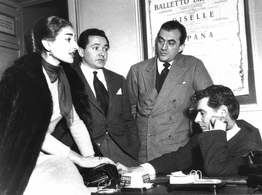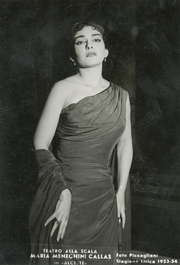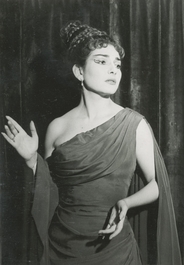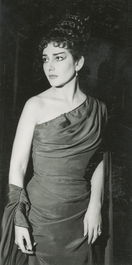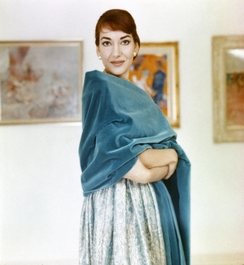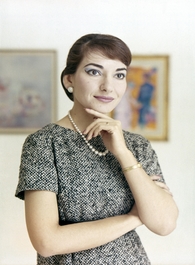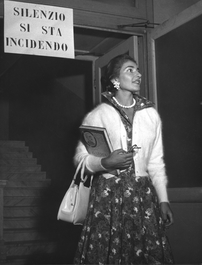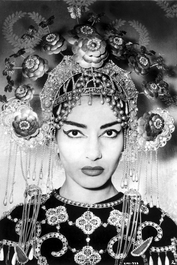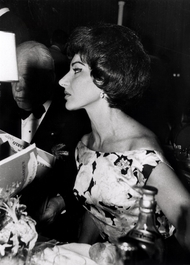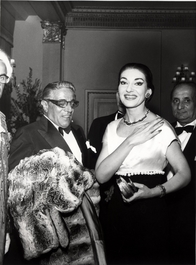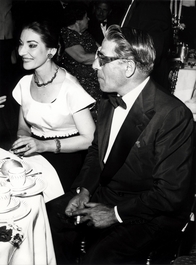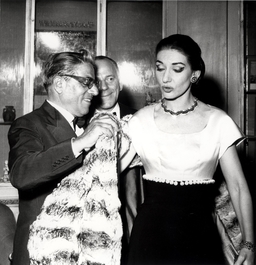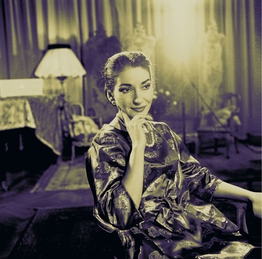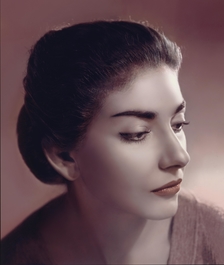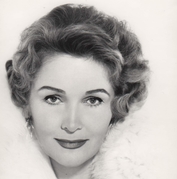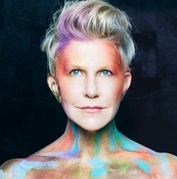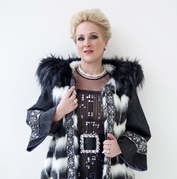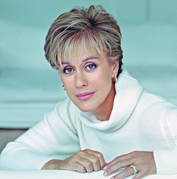

Maria Callas
News
Maria Callas website has been launched in Spanish
On September 25th Warner Classics launches the Spanish-language version of www.maria-callas.com. The official Maria Callas website first went live in English on December 2nd 2017, the legendary Greek-American soprano’s 94th birthday.
The launch coincides with the first dates of the Callas in Concert Hologram Tour of Mexico and South America. Created by BASE Hologram, the concert blends Warner Classics’ original recordings of Maria Callas’s voice with a live orchestra. Ending in Chile, the tour will visit Mexico, Brazil and Argentina – three countries that hosted important operatic appearances by Callas between 1949 and 1952. She did not sing in Spain until 1959, when she gave concerts in Madrid and Barcelona.
The official Maria Callas website is conceived both to reflect her status as a figure of major cultural importance and to encourage discovery of her life and her art. The administrators of the soprano’s estate have given their blessing to the project. Designed and built by Milan-based agency Uprising™, the site is timeless and elegant in design and its unique interactive offering can be experienced to full effect on Mac, PC, smartphone and tablet.
www.maria-callas.com is divided into four main sections: Life, Look, Voice and Today – in other words, biographical material (including animated illustrations with a voiceover telling her life story), photos and videos, discography and the latest news. Callas makes her presence felt on the homepage through an audio-reactive music visualizer, specially created to produce a visual analogue for Callas’ utterly distinctive voice – the essence of her being. The website also links to the official Maria Callas Playlist, to be found on DSPs such as Spotify, Apple Music, Deezer and Melon.
In its first nine months of existence www.maria-callas.com has excited considerable international interest, generating more than 80,000 user sessions and winning three awards: the Favourite Website Award, the CSS Design Award for Website of the Day and the AWWWARD Site of the Day. Over 50% of the visits have been made by people aged between 25 and 34, and 22% by people aged between 18 and 24. These figures confirm that, notably through digital media, Maria Callas continues to exercise her magic – as much on the younger generation as on music-lovers born during her lifetime. Her global reach is indicated by the large volume of visitors from China and India.
It is 41 years since Maria Callas died, aged just 53, in September 1977, but she remains an icon: as a supreme singing-actress and as a stylish and glamorous celebrity. Known as La Divina, Callas is still the epitome of the operatic diva for aficionados and the wider public, and today’s opera singers cite her time and again as an inspiration and influence. Having changed the face of her chosen art form, helping to shape its history, she has been the subject of plays and films and generates many millions of views on YouTube.
For decades, Callas has retained her place among the world’s top-selling classical artists. Warner Classics, as the official custodians of her recorded legacy, have in recent years issued two major editions of her recordings, enhancing the listener’s experience through discerning use of the latest audio technology: CALLAS REMASTERED: The Complete Studio Recordings (69 CDs) and Callas: Live (42 CDs). Hailed as revelatory, they have gone on to sell thirty thousands of copies.
The Maria Callas experience brought vividly to life via Hologram
‘I don’t know what happens to me on stage. Something else seems to take over.’ –Maria Callas
A new generation of opera lovers can experience the larger-than-life diva Maria Callas perform live in a worldwide concert tour, in the form of a three-dimensional hologram. BASE Hologram has captured Callas at the height of her powers with innovative technology and finely-honed stagecraft for a unique and compelling show: Callas in Concert — The Hologram Tour.
BASE Hologram has partnered with Warner Classics, the sole guardian of La Divina’s recorded legacy, to curate the official soundtrack and playlist of the tour. The Callas in Concert album mirrors the program and encores of the stage show, with her original iconic recordings, re-mastered in 24-bit/96kHz sound at Abbey Road Studios. (For The Hologram Tour, a team of highly experienced sound engineers isolated the voice of Callas so that her hologram incarnation could once again take the stage with a live orchestra.) The recital includes many of the arias in which she proved her prowess on stage and in the studio, and in which she remains unrivalled today: Bellini’s Casta Diva, Puccini’s Vissi d’Arte, Bizet’s L’Amour est un oiseau rebelle, among others.
This unique performance concept has been directed with expertise, respect and love by The Juilliard School’s Stephen Wadsworth (Masterclass), a veteran of the hallowed halls in which Callas reigned supreme, including La Scala, the Met and Covent Garden. ‘The event will appeal to generations of audiences who never experienced Callas and who may know little about her beyond her reputation, as well as to opera lovers who are very familiar with her work, her recordings, and her complex life story,’ said Wadsworth. ‘We’ve had the opportunity to curate one of the greatest artists of the 20th century, and we must do that with great care – from her fantastically diverse repertoire to her revealing gestural language and her complicated relationship with her audience. We are all in different ways close to Callas’ influence, because her work had a huge impact on every artist working in music, opera, acting, stage design and fashion.’
It’s the Maria Callas comeback we could only have dreamed of. The New York Times has hailed it ‘amazing...Callas – eerily, well, radiant in a white satiny gown and rich red stole – was recreated for the occasion, down to the minutest movements of her hands and the subtlest facial gestures.
‘Callas, a symbol of chic, remains an object of fascination extending even beyond opera fans. Perhaps the hologram will introduce some newcomers to her incredible artistry; I’d urge everyone to listen to Callas’s extensive discography. Like so many now, I loved her without ever seeing her live; this holographic specter was weirdly tantalizing.’
Although Maria Callas died, aged just 53, as long ago as September 1977, she remains the epitome of the operatic diva: the American-born Greek soprano who defined, and even redefined, opera in the 20th century, and who has never lost her place among the world’s top-selling classical artists. With music from the Warner Classics catalogue, BASE Hologram captures Callas at the height of her glory. She returns to the stage, in all her grandeur, confirming her immortality to stunned audiences. As this unprecedented performance unfolds, audiences will surrender all notions of what is real and get lost in the magic of undoubtedly the greatest opera singer of all time.
More details:
Official Maria Callas website
Maria Callas Official Instagram (@mariacallasofficial)
The official soundtrack out 14 September to coincide with the international Callas Hologram tour. (See www.maria-callas.com for more details.)
La Divina gets a digital makeover
On 30 January at the Museum of La Scala in Milan, Warner Classics launched the Italian version of maria-callas.com, the award-winning official Maria Callas website. It joins the English and French versions of the site, which went live on 2 December 2017, the date that would have marked the legendary soprano’s 94th birthday. The German version of maria-callas.com is in preparation.
At the launch event in Milan, this state-of-the-art digital tribute to Callas shared a space with physical mementos of the diva’s career at Italy’s greatest opera house. Her costumes and other artefacts were displayed in the exhibition Maria Callas On Stage - The Years at La Scala, which opened in September 2017 on the 40th anniversary of her death and continued until 31 January 2018.
maria-callas.com has already excited considerable international interest, generating more than 50,000 user sessions and winning three awards: the Favourite Website Award, the CSS Design Award for Website of the Day and the AWWWARD Site of the Day. Over 40% of the visits were from people aged between 18 and 34; this statistic confirms that, notably through digital media, Callas continues to exercise her magic – as much on the younger generation as on music-lovers born during her lifetime. Her global reach is indicated by the large volume of visitors from China and India.
In Autumn 2017 Warner Classics released the 42-CD set Maria Callas Live: Remastered Live Recordings 1949-1964, which complements the landmark 2014 release of Callas Remastered: The Complete Studio Recordings. It is one of Callas’s studio recordings that has been chosen for a new digital single (for streaming and download on all platforms), available this Friday, 2 February. It is the hauntingly lyrical aria ‘Casta diva’ from Bellini’s Norma, the opera Callas performed most frequently in her career, and in which she continues to reign supreme.
The single is taken from her second complete recording of the opera, made in 1960 at La Scala, the theatre which hosted the premiere of Norma in 1831. Conducted by soprano’s mentor, Tullio Serafin, ‘Casta diva’ brings a wealth of refinement and nuance from Callas as she sings the Druid priestess’s prayer to the moon goddess. The artwork for the single is taken from maria-callas.com – the page celebrating ‘Prima donna at La Scala’.
The first official website devoted to Maria Callas launches on 2 December
On Saturday 2 December, what would have been the 94th birthday of Maria Callas, Warner Classics launches the first official website dedicated to the legendary soprano, maria-callas.com. The site goes live on Saturday at 00.00 CET
It is 40 years since Maria Callas died, aged just 53, in September 1977, but she remains an icon: as a supreme singing-actress and as a stylish and glamorous celebrity. Known as La Divina, the American-born Greek soprano is still the epitome of the operatic diva for aficionados and for a wider public.
Callas changed the face of her chosen art form, helping to shape its history. She has been the subject of plays and films, she generates many millions of views on YouTube, and today’s opera singers acknowledge her time and again as both an inspiration and an influence.
For decades, she has retained her place among the world’s top-selling classical artists and Warner Classics has recently released Maria Callas Live: a 42-CD box set of her re-mastered live recordings. It has been hailed as revelatory.
Maria-Callas.com has been conceived both to reflect Callas’ status as a figure of major cultural importance and to encourage discovery of her life and her art. The soprano’s estate executors have given their blessing to the project. Designed and built by Milan-based agency Uprising™, the site is timeless and elegant in design and its unique interactive offering can be experienced to full effect on Mac, PC, smartphone and tablet. The launch version is in English, with French, Italian and German to follow over the next two months.
The site is divided into four main sections: Life, Look, Voice and Today – in other words, biographical elements (including animated illustrations and audio narration exploring her life on and off stage), archival photos and live performance videos, her complete, detailed Warner Classics discography and the latest Callas-related news and events from around the world. The voice of Callas is the heart of the website, and can be experienced in a new way thanks to an audio-reactive music visualizer which has been specially developed to produce a visual analogue for Callas’ utterly distinctive voice – the essence of her being, and of maria-callas.com.
Warner Classics unveils Maria Callas Live: Remastered Live Recordings 1949-1964
Although Maria Callas was just 53 when she died – 40 years ago on 16 September 1977 – she changed the face of opera for generations to come. Her legend has never faded: she remains the supreme singing-actress, the unsurpassed diva, and the glamorous style icon whose private life was often as dramatic as one of the tragic heroine’s she portrayed on stage.
Commemorating the 40th anniversary of her death in Paris, Warner Classics presents the Maria Callas Live edition: a deluxe 42-CD box set (also available as a digital download and on streaming platforms) drawing together La Divina’s live opera and recital recordings, with the invaluable inclusion of 12 roles Callas never recorded in the studio. These 20 complete operas and five complete filmed recitals on Blu-ray have been newly remastered from the highest quality source material with the cutting-edge technology of Studio Art et Son in Paris.
This unique collection captures in sumptuous sound the very heart of Callas’ artistry: it is on the stages of the world’s great opera houses and concert halls that the Maria Callas legend came to life. Thanks to faithful remastering, listeners can experience the great soprano’s voice in all its splendor and dramatic potency as if truly hearing her performing live, with recordings of unprecedented immediacy and authenticity.
The landmark box set contains a 200-page hard-back book with essays, a biography and chronology, as well as rare archival photographs of Maria Callas on stage. The cover art of each opera album in the collection presents an iconic photo of Callas in the corresponding performance.
Following the Success of MARIA CALLAS: THE STUDIO RECORDINGS REMASTERED
In 2014 Warner Classics, the guardian of Maria Callas’ official recorded catalogue, undertook a monumental remastering at London’s Abbey Road Studios of Callas’ Complete Studio Recordings, released as a 69-CD collectors’ set that met with resounding critical acclaim.
Maria Callas Live is the highly-anticipated follow-up to that groundbreaking studio collection, hailed by The New York Observer “a beacon illuminating the mysterious but indispensable art of Maria Callas…You couldn't ask for better than what Warner Classics has done with Maria Callas – The Studio Recordings Remastered.”
"The recording now sounds like a million dollars...Restoring to us the sound of the voice as it would have been heard in the studio,” declared Gramophone magazine.
The Maria Callas Live Remastered Edition, to be released on 15 September 2017, lives up to the proven quality and inspired curation established by Warner Classics with the 2014 Studio Recordings collection.
Today marks 110 years since the birth of legendary record producer Walter Legge
'If you examine Walter Legge's work from beginning to end, you will experience something extraordinary and grand. You will hear the work of a man with god-given musicality and imagination, and you will know that all the great artists who appear on these albums worked alongside Walter, with his attentive ears, with the greatest satisfaction.' -Elisabeth Legge-Schwarzkopf
That Walter Legge was a consummate musician is obvious to anybody who knows his work. Yet he received no formal education in music. The source of his knowledge was a local public library in west London. He played the piano, and before heavy smoking took its toll he possessed a good baritone voice; but poor eyesight and a certain lack of physical coordination prevented him from mastering any musical instrument. On one occasion he conducted an orchestra, but after a few minutes he put the baton down, realising that he could never obtain results to satisfy his own acute musical sensibilities.
If he could not reach great heights in making music himself, then he would create great music-making by inspiring others; in later years he referred to himself, with perhaps a touch of irony, as 'a midwife to music'. His first employment within the record industry came in 1929 through the help of the manager of the HMV shop in London's Oxford Street, who recommended him to senior company colleagues. Soon Legge was writing analytical notes for HMV album sets. He then became editor of the company's trade magazine, The Voice.
In the early 1930s, he formed the London Lieder Club, and made contact with some of the finest singers of the day. Early in 1934, he met Sir Thomas Beecham, who was sufficiently impressed to insist that the 27-year-old should produce all his Columbia recordings (HMV, Columbia and Parlophone had amalgamated in 1931 to form EMI Records Ltd). In 1938 Beecham appointed him as his Assistant Artistic Director for two international opera seasons at the Royal Opera House, Covent Garden.
The outbreak of war in September 1939 brought radical change to his working life. EMI continued to make recordings, though on a reduced scale, and Legge (rejected for war service on account of his poor eyesight) found himself responsible for all of the company's classical output. Among Beecham's last recordings before he departed for America in 1940 was one in which unusually he played the piano accompaniment for a young contralto, Nancy Evans, who was to become Legge's first wife the following year.
By June 1940, enemy forces occupied most of Europe, and Legge could only use British-based artists for his recordings. With young musicians returning from the fighting services, plus the pick of the players from other orchestras, Legge founded his Philharmonia Orchestra in October 1945. Almost immediately the new ensemble started to make recordings.
In 1946, Legge visited Vienna to renew contact with established artists and to seek new talent. Over the course of the next five years he made many recordings in Vienna, Lucerne, Prague, Berlin and Geneva, besides running his orchestra and maintaining a busy recording schedule in London. In 1951 he made recordings at the first post-war Bayreuth Festival, and in 1953 he made the first of a series of opera recordings in Milan's La Scala theatre. It was also in 1953 that he married his second wife, the soprano Elisabeth Schwarzkopf, whom he had met in Vienna seven years previously.
A flow of recordings for EMI (now Warner Classics) continued until 1964; he continued to supervise all of Elisabeth Schwarzkopf's recordings until her last sessions, three months before his death in March 1979. His recordings with Callas, Schwarzkopf, Karajan, Furtwängler, Klemperer, Lipatti and many of the greatest artists in the post-war era remain legendary today. He supervised some 3,500 recordings of separate works, large and small. Even in the most unpropitious circumstances, such as an unheated wartime town hall with a leaking roof, or when electrical power had to be provided via a power-driven generator in early post-war Vienna, he strove for the highest possibile artistic standards. He usually achieved his end. -Alan Sanders, 1996
"That woman is a miracle!" Elisabeth Schwarzkopf on Maria Callas
The revered director Luchino Visconti told a marvellous story about a performance of Il trovatore at La Scala in 1953. He arrived late and hardly noticed a woman seated behind him in his usual box. He was eager to hear Maria Callas.
Just as the great soprano finished singing D'Amor sull'ali rosee at the end of Act Four, he heard a voice exclaim, "That woman is a miracle!" He turned around and realised it was Elisabeth Schwarzkopf - the German soprano renowned for her formidable perfectionism - with tears streaming down her face.
This photo of the two sopranos together was taken in 1957 (Erio Piccagliani, courtesy of Teatro alla Scala). Both became elegant icons, immortal voices of their time, recording for the same label, EMI Classics (now Warner Classics) under the guidance of legendary producer Walter Legge - Schwarzkopf's husband.
In 2014, Warner Classics completed a monumental project at Abbey Road Studios in London: re-mastering the complete Maria Callas studio recordings in high definition from the original master tapes.
This year, for the Elisabeth Schwarzkopf centenary on 9 December, the same award-winning mastermind behind the Callas project has restored Elisabeth Schwarzkopf's complete recital recordings (1952-1974) to their original glory in luminous sound for a 31-CD collectors' boxed set.
Maria Callas' complete studio recitals released in a stylish 14-CD boxed set
Maria Callas is regarded as one of the greatest divas of all time, whose recordings of the Italian operatic repertoire have become the yardstick by which all subsequent performances and recordings are judged.
But in addition to the studio recordings of some 20 different operas, she also made 11 studio recital albums in which she sang not only scenes and arias from her stage repertoire, but other pieces as well that she never sang on stage.
These recital performances are an invaluable addition to Callas’s recorded legacy and show yet another side of this unique diva, whose vocal achievements stand unrivalled today and probably for all time.
The recitals demonstrate Callas’s exceptional versatility – from bel canto to verismo, dramatic mad scenes to impeccably sung coloratura. The great value of these recitals is magnified by the new transfers made at Abbey Road Studios in 2014, using 24-bit 96kHz remastering.
Maria Callas: The Complete Studio Recitals is out now, and features: Arturo Basile · Franco Corelli · John Lanigan · Georges Prêtre · Nicola Rescigno · Joseph Rouleau · Duncan Robertson · Tullio Serafin · Monica Sinclair · Antonio Tonini · Alexander Young
CD1 The First Recordings 24.04
CD2 Puccini Arias 45.03
CD3 Lyric & Coloratura Arias 48.53
CD4 Callas at La Scala 41.54
CD5 Verdi Arias I 49.30
CD6 Mad Scenes 47.33
CD7 Callas à Paris I 49.46
CD8 Callas à Paris II 43.53
CD9 Verdi Arias II 39.59
CD10 Mozart, Beethoven & Weber 44.29
CD11 Rossini & Donizetti Arias 39.54
CD12 Verdi Arias III 50.16
CD13 The Callas Rarities 1953–1961 63.20
CD14 The Callas Rarities 1962–1969 53.28
Iconic Maria Callas footage released on Blu-Ray with re-mastered surround sound
Few of Maria Callas's performances were filmed, so these gala concerts from London, Paris and Hamburg between 1958 and 1964, are truly special. Now, for the first time, they are available on Blu-Ray with stereo sound re-mastered at Abbey Road Studios.
Her appearance at the Opéra de Paris on 19 December 1958 conquered the City of Light. It was her first appearance in the city which she was to make her home and in which she was to die.
The splendour of this who's-who event at the Palais Garnier is captured on this Blu-Ray. When she appeared on stage, that slender, stylish figure, in the gown variously described as scarlet and champagne, adorned by a million dollars' worth of loaned jewellery, descended the staircase and stood before this glittering audience, was it not exactly the scene of which dreams are made? After the interval, the second act of Tosca has Callas on stage and in costume, with Tito Gobbi playing his unforgettable Scarpia.
It was a matter of some excitement when La Callas turned up unexpectedly as a surprise participant at the Royal Opera House, Covent Garden, on 4 November 1962 in a live television transmission of a gala concert with a number of other performers. She was in excellent vocal condition, and her assured singing of the extended dramatic scene 'Tu che le vanità' from Don Carlo largely dispelled the growing rumours about her voice. She then changed the mood completely and took on the character of a flirtatious gypsy girl in the Habanera and the Séguédille from the first act of Carmen, a role she was never to play on stage.
A Golden Hour TV gala was arranged at Covent Garden for the night of Sunday 9 February 1964, and it included the whole of the second act of Tosca in live transmission. This visual record of Callas is an invaluable document, preserving at least a part of that final stage triumph of the great diva, in a setting worthy of her art.
Her Hamburg concert on 15 May, 1959, includes a thrilling Una voce poco fa, which she frequently included in her concert programmes, savouring the complete contrast it afforded to the dramatic or tragic moods of much of her other recital repertoire.
In 1962, three years later, she returned to the Musikhalle on 16 March, and did not disappoint her Hamburg fans. The previous year in Paris she had recorded her first album of arias sung in French, and she duly opens her concert with three French items including the Habanera, clearly enjoying herself in this sensuous and provocative music.
But the finest is left to last, when she gives a blazing account of the great aria O don fatale from Don Carlo, closing the concert with the unique combination of musical sensibility, interpretive skill and sheer driving power that only Callas at her best could deliver.
Lead actress in Niki Caro's high-profile Maria Callas biopic revealed
First she was the girl with the dragon tattoo. Now, Swedish actress Noomi Rapace trades in her piercings and leather jacket for Van Cleef & Arpels to play the most iconic diva of all time, Maria Callas.
The biopic, titled simply Callas, has been a passion project for New Zealand-born filmmaker Niki Caro (Whale Rider), whose screenplay (based on Alfonso Signorini’s biography Too Proud, Too Fragile) focuses on the romance and ill-fated affair between the star opera singer and shipping magnate Aristotle Onassis. The relationship ended in 1968 when the latter left a devastated Callas for presidential widow Jacqueline Kennedy.
Heartbreak and tragedy are as much a part of the La Divina legend as the voice and glamour, all inextricably woven together in her art.
The filmmakers will be pitching the project to buyers at the Cannes Film Festival this week.
Related releases









